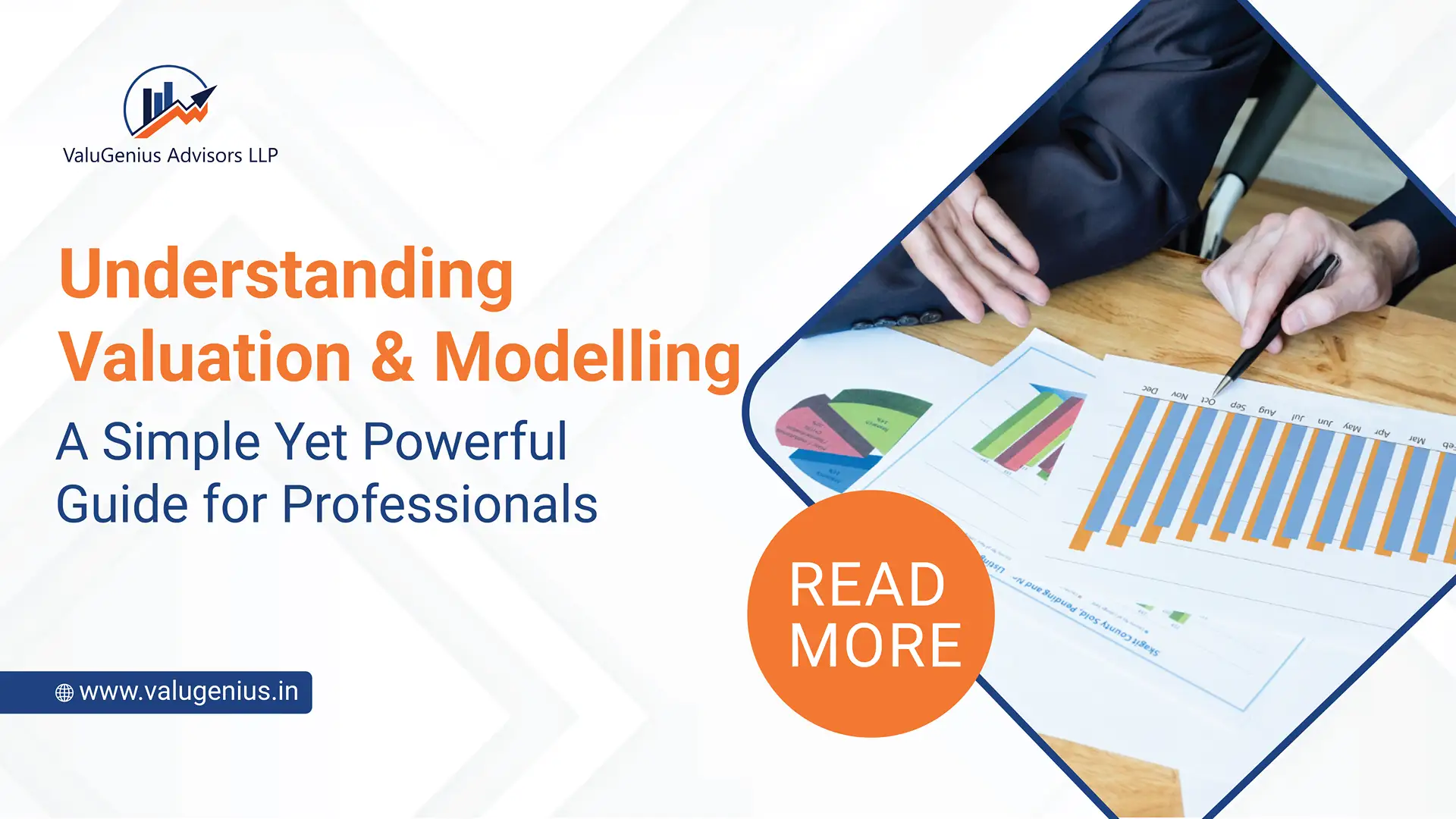
Understanding Valuation & Modelling: A Simple Yet Powerful Guide for Professionals
In the world of business and finance, the terms valuation and financial modelling often raise eyebrows.
They might sound technical, rigid, even a little intimidating. Yet, at heart, they’re deeply human tools—tools that help us answer meaningful questions: What is this business really worth? Where should we invest our time, money and energy? Can we make smarter decisions instead of just guessing?
Whether you’re in the boardroom of a large enterprise, working at a boutique financial planning company in Mumbai, or advising clients about building value, understanding valuation and modelling gives you the clarity and confidence to act. And yes the friendly team at ValuGenius (a specialist in valuation and modelling) is ready to help you master it.
What is Valuation in Financial Modelling?
Simply put: valuation in financial modelling is the process of estimating the current worth of a business, asset or project by using historical data plus projections.
You analyse the business’s figures, make assumptions about its future, and then apply models such as:
- Discounted Cash Flow (DCF) – estimate future cash flows, then bring them back to today using a discount rate.
- Comparable Company Analysis (CCA) – assess how similar companies are valued (multiples, metrics) and apply that to your subject.
- Precedent Transactions Analysis – look at past deals in the same industry and apply those multiples.

Why Valuation in Financial Modelling Matters
Here’s why valuation is not just academic—it’s practical, strategic and business-critical:
- Investment decision-making: Investors ask: Is this company overvalued or undervalued? Valuation helps answer that.
- Mergers & acquisitions (M&A): Whether buying or selling a business, you need to know a fair price. Valuation models give a defensible number.
- Corporate finance strategy: Expanding a business, raising capital, restructuring debt? Valuation helps you decide if the venture will create value.
- Performance evaluation: By comparing intrinsic value with market value, companies can see if they’re under-performing on value creation.
In short: For business owners, advisers, financial-planning firms in Mumbai (and beyond), and professionals supporting growth and exits, understanding valuation is indispensable.
Common Techniques of Valuation in Financial Modelling
Let’s walk through key methods (in simple English):
1. Discounted Cash Flow (DCF) Model
- Forecast: future cash flows (revenues, less expenses, capital expenditures, working capital).
- Choose a discount rate (often WACC – Weighted Average Cost of Capital).
- Discount the cash flows back to present value.
- Add a terminal value (value after the forecast period)..
Use When: You have reasonable projections and want to capture long-term value

2. Precedent Transactions Model
- Gather past M&A deals in the same or similar industry.
- Look at multiples used (e.g., EV/EBITDA, Price/Earnings).
- Adjust for size, growth, risk differences and apply to subject business.
Use When: You want to show how the market has valued similar companies in real deals
3. Leveraged Buyout (LBO) Model
- Imagine acquiring a business using significant debt.
- Model how cash flows pay down debt, what the exit price is, calculate IRR.
Use When: For private‐equity style deals or buy-outs.
4. Dividend Discount Model (DDM)
- For companies that pay dividends: Forecast dividends, then discount back to present.
Use When: Dividend payment is predictable and the main return to shareholders.
5. Residual Income Model
- Value = Book value + present value of future residual incomes (net income minus required return on equity). Use When: Firms are profitable but dividend payments are irregular.
6. Asset-Based Valuation Model
- Sum up market value of assets, subtract liabilities.
- Includes tangible (land, machinery) and intangible assets (brand, patents).
Use When: Asset-rich or liquidation scenario (or when earnings are unpredictable).
7. Real Options Valuation Model
- Treat project-choices (expand, abandon, delay) like financial options value flexibility.
Use When: High uncertainty, multiple future decision-paths (R&D, natural resources).
8. Sum of the Parts Valuation
- Break business into different units, value each separately, then add up.
Use When: Conglomerates with diverse business divisions.
9. Cost Approach Model
- Estimate current cost to replace or reproduce the asset, adjust for depreciation or obsolescence.
Use When: Unique assets, infrequently traded, tangible heavy.
How to Choose the Right Valuation Technique
Because no one model fits every scenario, the choice depends on multiple factors:
- Nature of the Asset: Is it a start-up, mature company, real estate or financial security?
- Data Availability: Do you have historic financials, projections, comparable companies or transaction data?
- Purpose of Valuation: Is it for investment, M&A, reporting, taxation or internal strategy?
- Risk & Uncertainty Level: The more uncertain the forecast, the more you may rely on market or asset-based models.
- Industry Practices: Some industries favour multiples (e.g., tech) while others lean on asset/balance sheet (e.g., real estate).
- Comparability: Are there enough comparable companies or transactions?
- Complexity of Cash Flows: Simple business? Go with DCF or multiples. Complex? You may need real options or sum-of-parts.
- Regulatory or Reporting Requirements: In India, certain valuations must meet compliance under Institute of Chartered Accountants of India (ICAI) standards.
Valuation in the Indian Context
Because you’re focused on India and valuations in India as part of your domain, here are some important things to keep in mind:
- In India, business valuation is increasingly strategic not just for compliance.
- Many Indian valuation engagements face challenges: lack of standardisation, subjectivity in assumptions, information gaps.
- Some trends in Indian valuations: growing importance of intangible assets (brands, IP), technology-driven methods, investor focus on growth potential.
- One statistic: According to a study, for acquired companies in India, about 28% of enterprise value was allocated to identifiable intangible assets, and around 35% to goodwill.
- Another: A global study noted that India ranked third in the world for the highest “intangible component” as a percentage of total enterprise value.
- Organisations such as ICAI have issued educational material on valuation approaches and methods.
For professionals working at financial planning companies in Mumbai, or those advising Indian SMEs or listed companies, recognising these Indian-specific nuances gives you an edge.
How ValuGenius Helps You
We at ValuGenius, we believe valuation and modelling should be human-centred: clear, actionable, and tailored—not just theoretical.
Here’s how we support you:
- Customised Valuation Advisory: Whether you’re an SME owner, a startup pitch team, or a financial planning firm in Mumbai, we help you choose the right method, build the model, stress-test it and present the story.
- Indian Market Expertise: We understand India’s regulatory, tax and business environment—including valuation nuances in India.
- Finance-Friendly Models: We build models that non-financial professionals can understand and use—so board members or business owners aren’t left in the dark.
- Strategic Insights: Beyond numbers, we help translate valuations into decisions: “What can we do to improve value?”, “What happens if we change growth rate or margin?”, “How does this compare with valuations in our industry?”
In short: If you want valuation to be not just a number—but a tool for growth and decision-making—ValuGenius has you.
Final Thoughts
Valuation and modelling might seem like complex finance jargon—but actually they’re powerful, human tools that let you bring clarity to ambiguity, turn data into decisions, and give business value a voice. For professionals, especially those in India, working with Indian companies, or advising at financial planning companies in Mumbai the key is:
- choose the right technique,
- ground it in good data and assumptions,
- adapt it to the local (Indian) context,
- then use it not just to value but to act.
And if you’re looking for a partner who speaks your language (both finance and human), blends technical rigour with clarity, and can help you or your clients make sense of valuation—ValuGenius is here for you.

